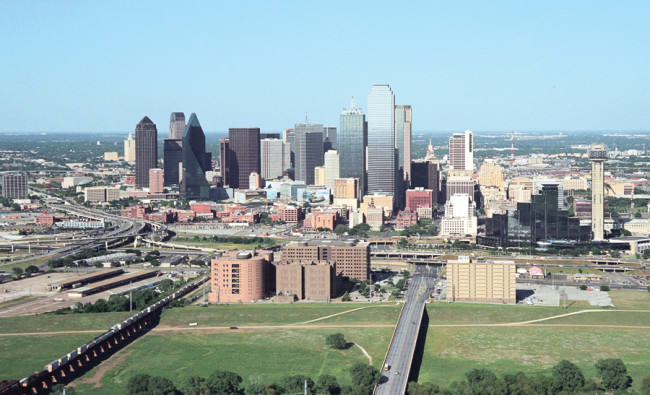
No city in America is perfect, and each has area-specifc problems that affect the health of their residents. Everything from air pollution and communicable diseases to obesity rates and substance abuse are health issues for cities.
Unfortunately Dallas is no different. Here are some of the harmful risks posing a threat to wellness in North Texas.
Air Pollution
When it comes to pollution, Dallas has a few a problems at hand. Precisely 70 percent of pollution is caused by emissions associated with cars, airplanes, trains and construction equipment according to Shannon Stevenson, program manager for the air-quality planning and operations team at the North Central Texas Council of Governments (NCTCOG).
Due to the excessive amounts of vehicles on the roads and Dallas being part of a metro area, this poses a challenge in regulating many jurisdictions. Being located in North Texas doesn’t help the city’s pollution problem either. Houston has the benefit of coastal winds, but those winds blow Houston’s pollution to Dallas. Regardless of where the pollution is coming from, it’s still this city’s problem to solve.
As for as the Texas Commission on Environmental Quality (TCEQ) is concerned, the pollution level in Dallas is still above federal standards. In 2010, the city’s ozone levels were worse than in Atlanta, Chicago, Miami, Washington, D.C., and New York.
Dallas has made some great improvements over the past decade in progressing air quality. The ozone levels have improved by 15 percent between 2000 and 2012.
Although Texas has made strides toward having cleaner air, but Dallas still had a long way to go according to WebMD.com. The website ranked Dallas the eighth worst smog city in America in 2013. The main suspects causing the city’s problem are traffic, extreme heat and frequent droughts which worsen the unhealthy ozone.
Local governments are implementing policies that will improve transportation emissions levels. Only one other metro area in the nation has higher amounts of electric vehicle charging stations based on population density. The NCTCOG also offers subsidies to businesses to replace older vehicles with ones that are low-emitting and cleaner.
Water Quality
Due to local tracking sites, the water quality of surrounding local communities are becoming a major concern. The University of Texas at Arlington surveyed privates wells across 13 counties in Arlington, Fort Worth and other areas just west of Dallas.
The researchers discovered some disturbing and potentially harmful findings. The closer people live to drilling sites, the greater chance they have of having unsafe levels of arsenic in drinking water.
Arsenic is linked to many health concerns including cancer and neurological development defects. UTA’s report hopes to persuade the companies behind the fracking to develop better practices.
Although this is a problem for areas near drilling sites, Dallas’ overall water quality currently meets all federal requirements. The 2013 Water Quality Report by the Dallas Water Utilities (DWU) reports that Dallas’ drinking water not only meets, but exceeds requirements and is safe to drink. The DWU is considered to be a superior water system by the TCEQ.
Alcohol Consumption
With an active nightlife scene, Dallas knows how to party — maybe partying too hard and drinking too much. According to the most recent data from the National Institute on Alcohol Abuse and Alcoholism (NIAAA) Texas drank more than 606 million gallons of beer in 2011, which is roughly 10 percent of the nation’s total beer consumption.
An average Texan drink less wine than the average American, yet Texans are drinking twice as much wine as they drank back in 1977. The consumption of wine has noticeably increased within the past few years as well.
In total, the average Texan in 2011 drank more than two gallons of alcohol. Texans may drink enough, but what is considered to be one too many? Well NIAAA said more than seven drinks for women and more than 14 for men.
Several consequences are associated with alcohol abuse, such as risk of death or injury due to motor vehicle crashes, violence, drowning and chronic diseases like heart and liver along. Excessive drinking can also result in cancer and a variety of mental health issues.
Traffic Accidents
Despite efforts to make Dallas more bike and pedestrian-friendly, it is clear to see that the city was built for driving. An one-way, daily commute is about 25 minutes on average, and as more people are moving to the Dallas area there are more cars than ever on the roads.
In the United States there are more than 6 million car accidents each year meaning that every 12 seconds someone dies in a car crash and every 14 seconds someone is seriously injured. With congested intersections and engrossed freeways, traffic accidents are a real threat to the people of Dallas.
In 2011, there were 103 fatal car accidents involving a total of 226 people. There were also 30 pedestrians involved in fatal car accidents. Of those accidents, 40 percent are caused by drunk drivers while 30 percent are attributed to exceeding the speed limit and another 33 percent are a result of reckless driving.
The majority of accidents could be prevented by simply driving more responsibly. This includes not doing other activities while driving like texting, talking on the phone and eating.
The best piece of advice for staying safe while behind the wheel is to buckle up. Coming as no surprise seat belts save lives. In more than half of all fatal car accidents the victims weren’t wearing seat belts when the crash occurred, even though seat belt laws have been enforced for years.
Smoking
No matter the city, smoking is a bad habit and the No. 1 preventable cause of death in the nation. Still, it kills more than 450,000 people each year. In Texas, tobacco use contributes to one in five deaths.
If the smoking rates in Texas continue, the state will have the highest number of children who become smokers and will die prematurely because of smoking, according to the Center for Disease Control just last week.
The City of Dallas’ smoking ordinance states that there are no longer any designated smoking areas in public workplaces, restaurants and bars. The ordinance was to give co-workers the right to not be exposed to secondhand smoke.
People who are exposed to secondhand smoke are 30 percent more likely to be diagnosed with heart disease and cancer while smokers have an 80 percent increased risk.
Currently there is a trend among smokers to quit, although kicking the habit can be easier said than done. Less than 10 percent of people who quit cold turkey are able to stay away from using tobacco and 30 to 40 percent of people who use medicine are successful. Many people have to try and quit several times, but the key is to want to quit and to have a support network.







